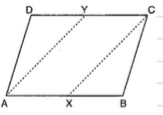ABCD is a parallelogram, and a,b,c and d are the position vector of vertices A,B,C and D of a parallelogram choose the correct option.
c+b=d−a
c−b=d−a
c−c=d−a
None of these
To solve the problem regarding the parallelogram ABCD with position vectors a,b,c, and d for vertices A, B, C, and D respectively, we need to analyze the relationships between these vectors.
1. Understanding the Position Vectors:
- Let the position vectors of the vertices be defined as follows:
- a = Position vector of vertex A
- b = Position vector of vertex B
- c = Position vector of vertex C
- d = Position vector of vertex D
2. Identifying Relationships in a Parallelogram:
- In a parallelogram, opposite sides are equal in length and direction. Therefore, we can express the relationship between the position vectors:
- The vector −−→AD is equal to the vector −−→BC.
3. Expressing the Vectors:
- The vector −−→AD can be expressed as:
−−→AD=d−a
- The vector −−→BC can be expressed as:
−−→BC=c−b
4. Setting the Vectors Equal:
- Since −−→AD=−−→BC, we have:
d−a=c−b
5. Rearranging the Equation:
- Rearranging the above equation gives us:
d−a=c−b⟹c−b=d−a
6. Conclusion:
- Thus, we find that the correct relationship is:
c−b=d−a
- Therefore, the correct option is option 2: c−b=d−a.
Final Answer:
The correct option is Option 2: c−b=d−a.
- Let the position vectors of the vertices be defined as follows:
- a = Position vector of vertex A
- b = Position vector of vertex B
- c = Position vector of vertex C
- d = Position vector of vertex D
- In a parallelogram, opposite sides are equal in length and direction. Therefore, we can express the relationship between the position vectors:
- The vector −−→AD is equal to the vector −−→BC.
- The vector −−→AD can be expressed as:
−−→AD=d−a
- The vector −−→BC can be expressed as:
−−→BC=c−b
- Since −−→AD=−−→BC, we have:
d−a=c−b
- Rearranging the above equation gives us:
d−a=c−b⟹c−b=d−a
- Thus, we find that the correct relationship is:
c−b=d−a
- Therefore, the correct option is option 2: c−b=d−a.
The correct option is Option 2: c−b=d−a.
Topper's Solved these Questions
Similar Questions
→a,→b,→c are the position vectors of vertices A, B, C respectively of a paralleloram, ABCD, ifnd the position vector of D.
View SolutionLet ABCD be as parallelogram. If →a, →b, →c be the position vectors of A, B, C respectively with reference to the origin O, find the position vector of D reference to O.
View Solution
Knowledge Check
ABCD is parallelogram →A,→B,→Cand→D are the position vectors of vecticles A, B, C, and D with respect to any origin, them:
A→A+→B=→C−→DB→C−→B=→A+→DC→B−→C=→A−→DD→A+→B+→C+→D=0If →a,→b,→c are the position vectors of corners A, B, C or a parallelogram ABCD, then what is the position vector of the corner D?
A→a+→b+→cB→a+→b−→cC→a−→b+→cD−→a+→b+→cABCD is a parallelogram with AC and BD as diagonals. Then, A→C−B→D=
A4A→BB3A→BC2A→BDA→B
In Figure, ABCD is a parallelogram and X,Y are the mid=points of sides AB and DC respectively. Show that AXCY is a parallelogram.

View SolutionIf →a,→b,→c,→d respectively, are position vectors representing the vertices A, B, C, D of a parallelogram, then write →d in terms of →a,→b and →c.
View SolutionIf ABCD is a parallelogram and A(−2,4),B≡(−3,5)andD(3,−2) Find the co-ordinates of C
View SolutionIf →a,→b,→c are the position vectors of corners A, B, C of a parallelogram ABCD. Then what is the position vector of the corner D?
View SolutionIf ABCD is a parallelogram and the position vectors of A,B and C are ˆi+3ˆj+5ˆk,ˆi+ˆj+ˆkand7ˆi+7ˆj+7ˆk, then the poisition vector of D will be
View Solution
